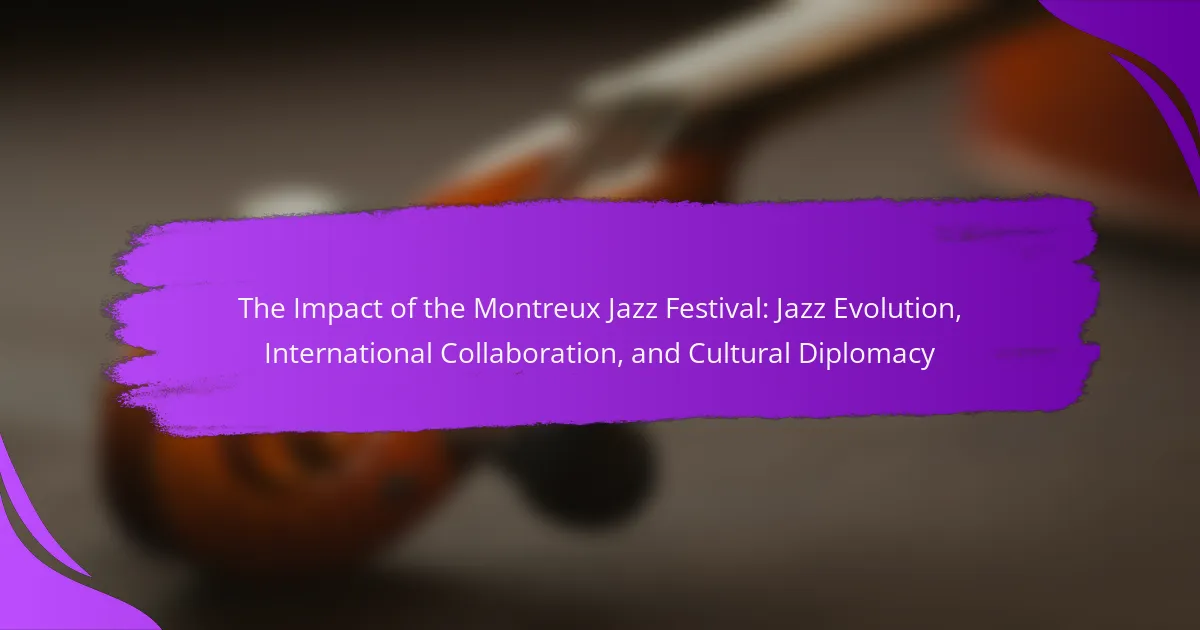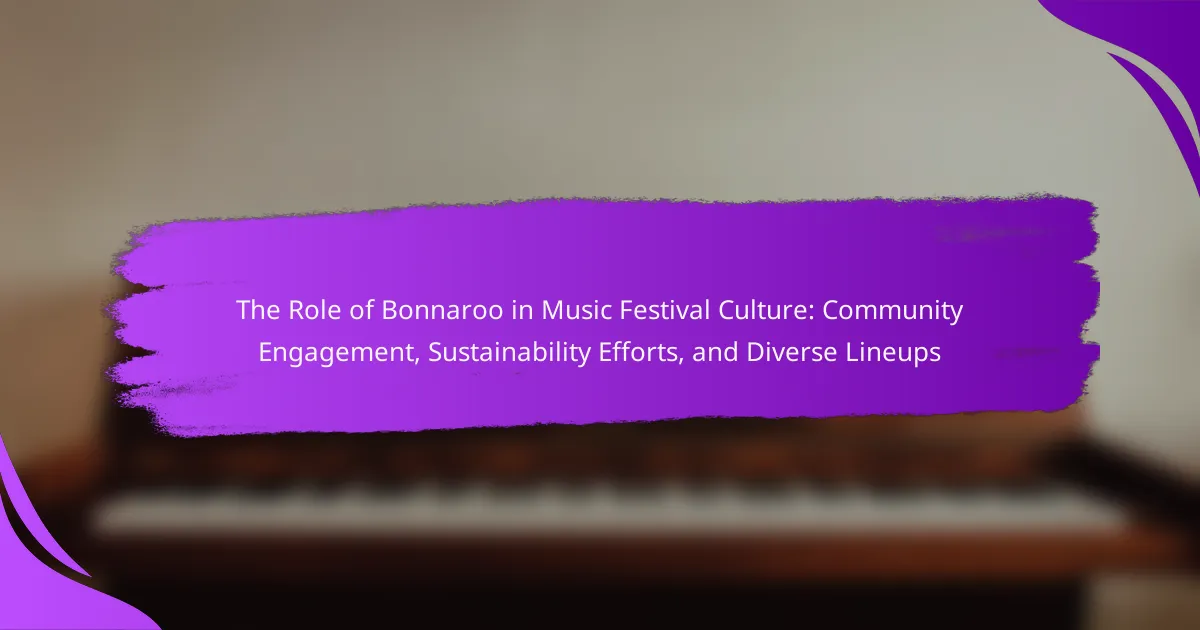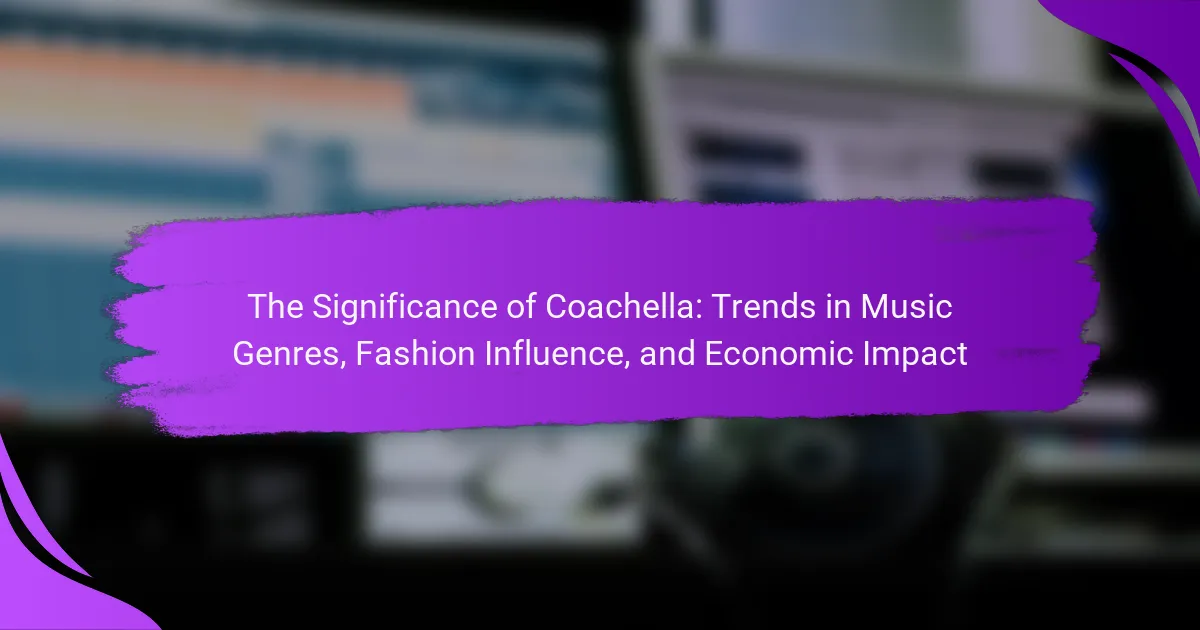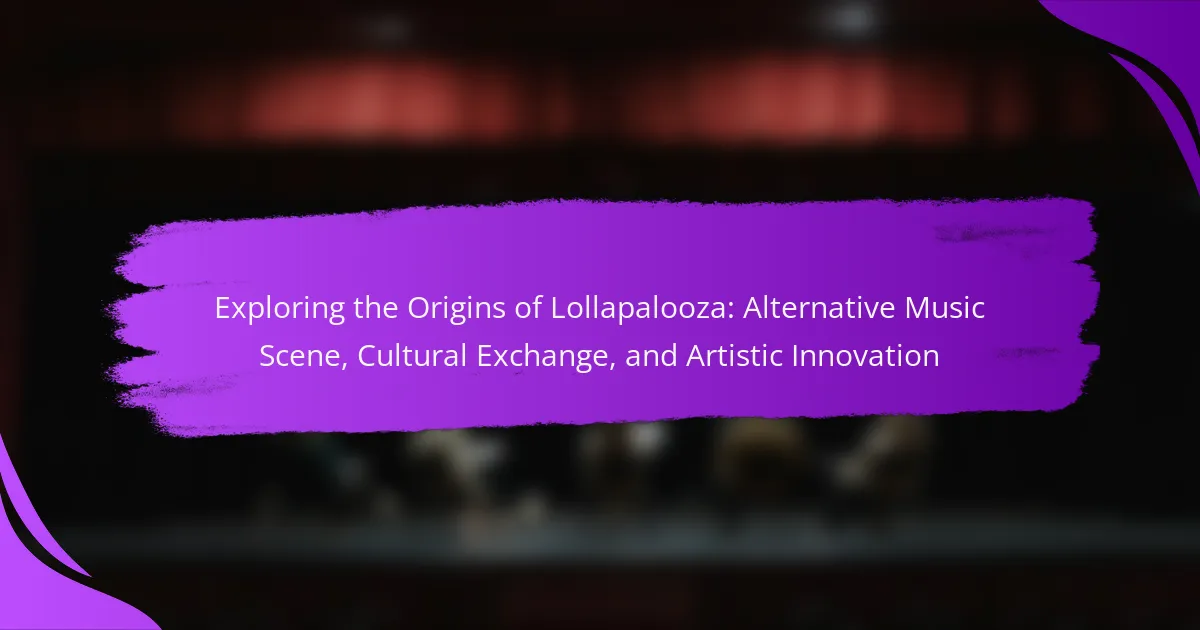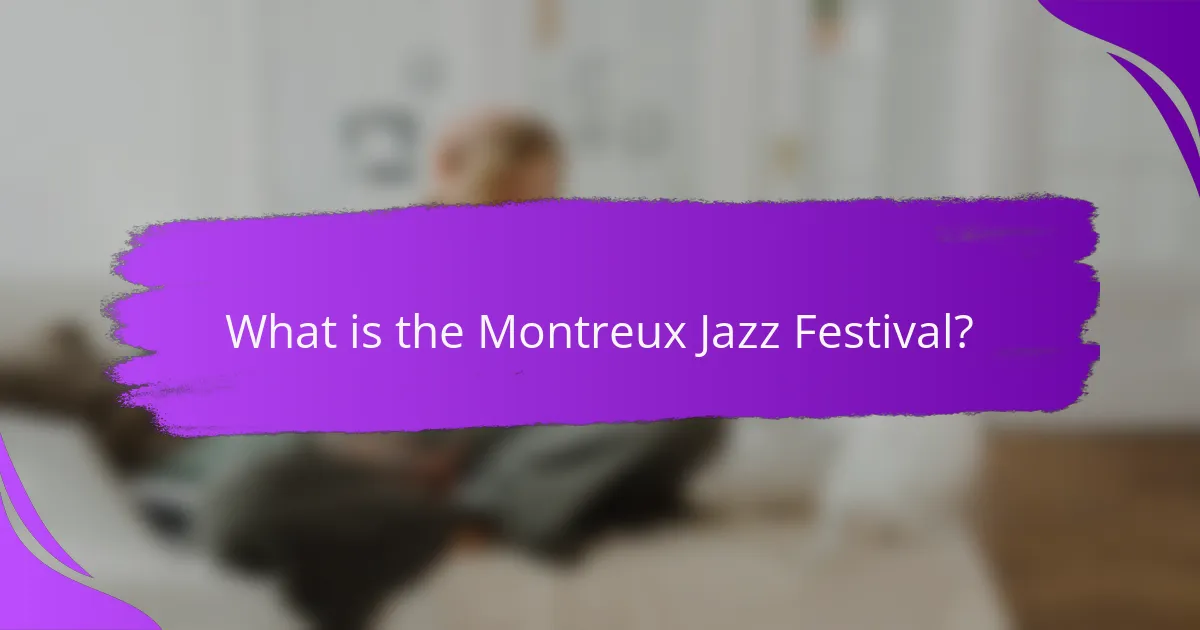
What is the Montreux Jazz Festival?
The Montreux Jazz Festival is an annual music festival held in Montreux, Switzerland. It was founded in 1967 by Claude Nobs. The festival primarily focuses on jazz music but also features a wide range of genres. These genres include rock, pop, and blues. The event attracts thousands of visitors each year. It showcases both renowned artists and emerging talent. The Montreux Jazz Festival has become one of the most prestigious music festivals globally. It plays a significant role in promoting cultural exchange and collaboration.
How did the Montreux Jazz Festival originate?
The Montreux Jazz Festival originated in 1967. It was founded by Claude Nobs, a Swiss hotelier. The festival started as a small jazz event. It took place in the Montreux Casino. Initially, it featured local and international jazz musicians. Over the years, it expanded to include various music genres. The festival gained popularity and attracted global artists. Today, it is one of the most renowned music festivals worldwide.
What were the initial goals of the festival?
The initial goals of the Montreux Jazz Festival were to promote jazz music and create a platform for artists. The festival aimed to showcase both established and emerging talents. It sought to foster cultural exchange among musicians from diverse backgrounds. Additionally, the festival aimed to enhance the cultural landscape of Montreux and attract visitors. These goals were rooted in a desire to celebrate musical creativity and innovation. The festival has since grown to include various genres beyond jazz, reflecting its evolving mission.
Who were the key figures involved in its establishment?
The key figures involved in the establishment of the Montreux Jazz Festival include Claude Nobs, who was the founder and driving force behind the festival. Nobs initiated the festival in 1967, aiming to create a platform for jazz music. He collaborated with notable musicians and industry professionals to develop the event. The festival quickly gained recognition for its diverse line-up and innovative spirit. Nobs’ vision attracted international artists and audiences, enhancing cultural exchange. His leadership and passion for music were crucial in shaping the festival’s identity. Over the years, the Montreux Jazz Festival evolved into a significant cultural event, reflecting Nobs’ dedication to jazz and collaboration.
What is the significance of the Montreux Jazz Festival in the jazz genre?
The Montreux Jazz Festival is significant in the jazz genre as it showcases a diverse array of artists and styles. Established in 1967, it has become one of the world’s most prestigious music festivals. The festival has hosted legendary jazz musicians, including Miles Davis and Ella Fitzgerald. It serves as a platform for both established and emerging artists. The event fosters international collaboration among musicians from various genres. It has expanded beyond jazz to include blues, rock, and pop, influencing the genre’s evolution. The Montreux Jazz Festival also promotes cultural diplomacy through music, uniting people across different backgrounds. Its impact on the jazz genre is profound, shaping the global music landscape.
How has the festival influenced jazz music over the years?
The Montreux Jazz Festival has significantly influenced jazz music over the years. It has provided a platform for emerging artists and established musicians. The festival has introduced innovative styles and collaborations. Notable performances have included jazz legends and contemporary artists. The festival’s international scope has facilitated cross-cultural exchanges. This has led to the fusion of jazz with various musical genres. The event has also preserved jazz’s historical roots while encouraging experimentation. Overall, the Montreux Jazz Festival has shaped the evolution of jazz music globally.
What notable performances have defined the festival’s legacy?
The Montreux Jazz Festival’s legacy is defined by numerous notable performances. One significant performance was by Nina Simone in 1976. Her emotional rendition of “Feeling Good” captivated the audience. Another landmark moment came in 1991 when Prince performed a surprise set. This performance showcased his innovative style and left a lasting impression. In 2006, the late David Bowie delivered a memorable show, highlighting his eclectic musical range. Additionally, the 2013 performance by Quincy Jones celebrated his extensive career and collaborations. These performances have collectively shaped the festival’s reputation as a premier platform for musical excellence.
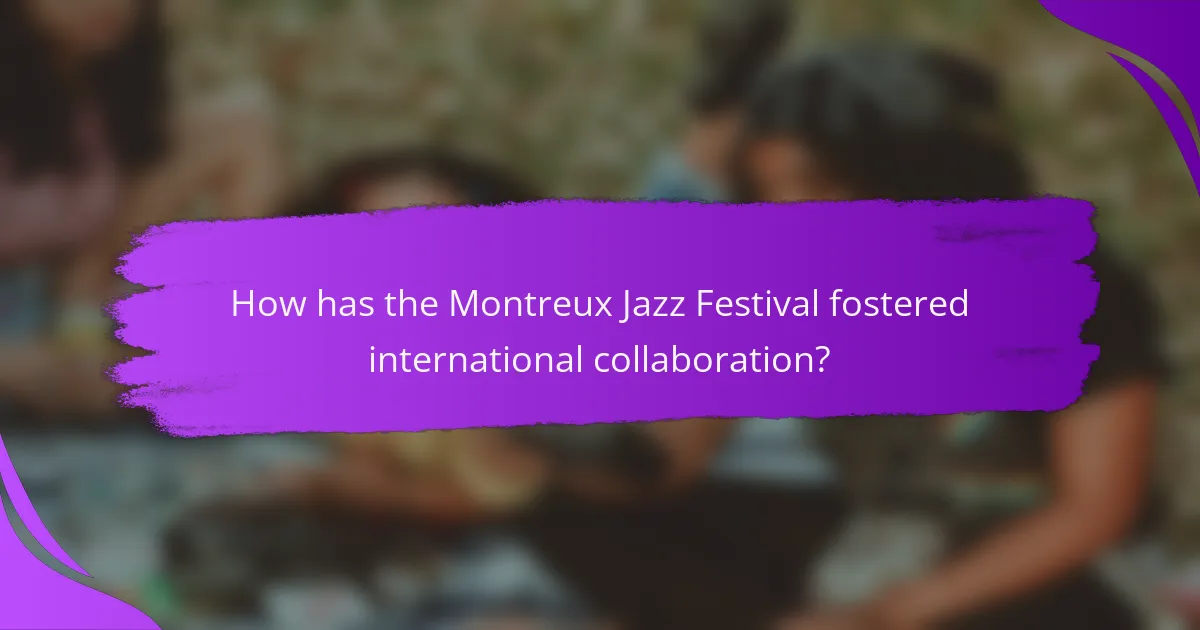
How has the Montreux Jazz Festival fostered international collaboration?
The Montreux Jazz Festival has fostered international collaboration by bringing together artists from diverse musical backgrounds. It features performers from various countries, creating a global platform for cultural exchange. The festival encourages cross-genre collaborations, blending jazz with other music styles. This approach attracts a wide audience, enhancing cultural appreciation. The Montreux Jazz Festival also hosts workshops and masterclasses, facilitating knowledge sharing among musicians. This engagement promotes networking opportunities for artists worldwide. Historical collaborations at the festival have led to unique musical projects, further enriching the global music scene. The festival’s international reputation attracts participants from over 40 countries each year, solidifying its role in fostering global connections.
What role does the festival play in bringing together global artists?
The festival serves as a significant platform for global artists to collaborate and showcase their talents. It attracts musicians from diverse backgrounds and genres. This diversity fosters creative exchanges and cultural dialogue. The Montreux Jazz Festival has hosted artists like Miles Davis and Nina Simone, highlighting its international appeal. The festival’s programming includes workshops and jam sessions, encouraging interaction among artists. These activities promote networking and collaboration across different musical styles. Furthermore, the festival’s global audience amplifies the artists’ reach and impact. This convergence of talent contributes to the evolution of jazz and other music forms.
How do collaborations at the festival enhance cultural exchange?
Collaborations at the festival enhance cultural exchange by bringing together diverse artists from various backgrounds. These partnerships create a platform for sharing unique musical styles and traditions. Artists collaborate on performances that blend different genres, fostering innovation. This interaction allows audiences to experience a fusion of cultures through music. For example, collaborations between local musicians and international stars often highlight regional sounds alongside global influences. The festival’s environment encourages dialogue and understanding among participants. This exchange promotes appreciation for different cultural heritages. Ultimately, such collaborations contribute to a richer, more inclusive cultural landscape.
What are some examples of successful international collaborations?
The Montreux Jazz Festival exemplifies successful international collaborations in music. Artists from diverse countries unite to create unique performances. For instance, the collaboration between American jazz legend Quincy Jones and French musicians has produced memorable concerts. Another example is the partnership between Swiss and Brazilian musicians, which blends cultural influences. Additionally, the festival has featured international acts such as Herbie Hancock and Angélique Kidjo. These collaborations enhance cultural exchange and promote jazz globally. The festival’s international reach attracts artists and audiences from around the world.
How does the festival contribute to the global music industry?
The Montreux Jazz Festival significantly contributes to the global music industry by promoting diverse musical genres and fostering international collaboration. It attracts artists from various backgrounds, enhancing cultural exchange. The festival serves as a platform for emerging talent, providing exposure to a global audience. In 2023, it featured over 200 artists from 40 countries, showcasing a wide range of musical styles. This diversity enriches the music landscape and encourages innovation. Additionally, the festival generates substantial economic impact, with an estimated revenue of 80 million Swiss francs annually. This financial boost supports local businesses and the broader music ecosystem. Overall, the Montreux Jazz Festival plays a vital role in shaping the global music industry through cultural diplomacy and artistic collaboration.
What partnerships has the festival formed with other music events?
The Montreux Jazz Festival has formed partnerships with various music events globally. Notably, it collaborates with the North Sea Jazz Festival in the Netherlands. This partnership promotes cross-cultural exchange and showcases diverse musical genres. Additionally, the festival has engaged with the Montreux Comedy Festival, enhancing its cultural offerings. These collaborations foster international relationships in the music industry. The partnerships significantly contribute to the festival’s reputation and expand its audience reach.
How does the festival support emerging artists worldwide?
The Montreux Jazz Festival supports emerging artists worldwide through various initiatives. It provides a platform for new talent to perform alongside established musicians. The festival features a dedicated stage for emerging artists, allowing them to showcase their work. Additionally, it offers workshops and mentoring sessions led by industry professionals. These opportunities help artists develop their skills and network within the music industry. The festival also promotes cross-cultural collaborations, connecting artists from different backgrounds. This exposure can lead to international recognition and career advancement. Overall, the Montreux Jazz Festival plays a significant role in nurturing the next generation of musicians.
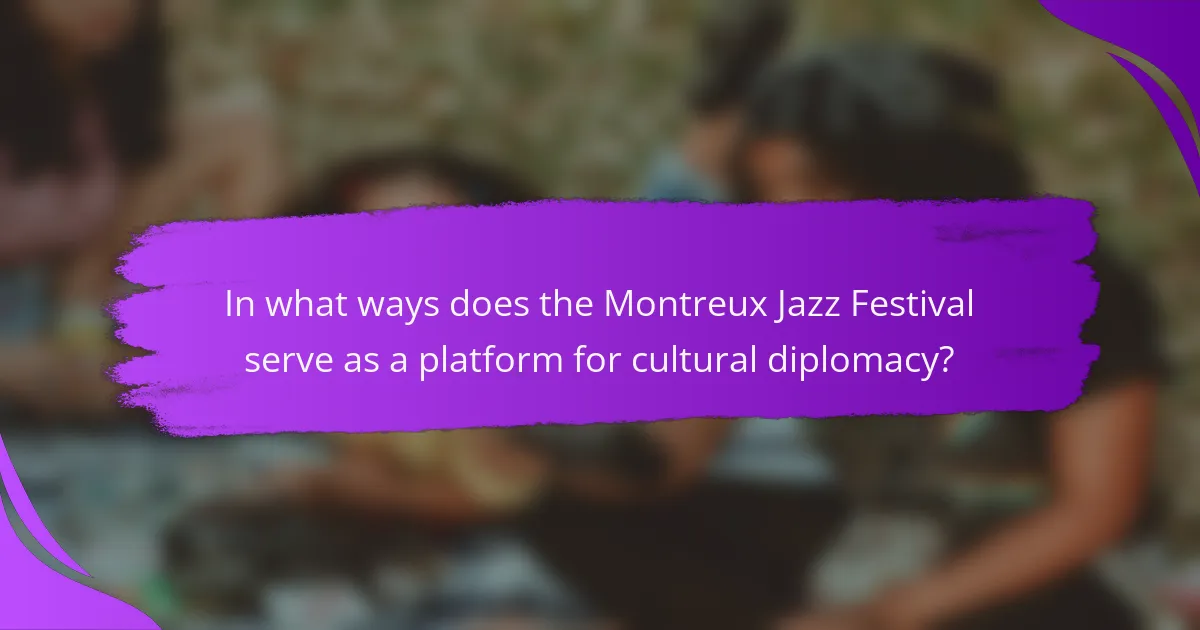
In what ways does the Montreux Jazz Festival serve as a platform for cultural diplomacy?
The Montreux Jazz Festival serves as a platform for cultural diplomacy by fostering international collaboration through music. It attracts artists from diverse backgrounds, promoting cross-cultural exchange. The festival showcases various genres, highlighting global musical traditions. This inclusivity encourages dialogue among different cultures. Additionally, the event draws attendees from around the world, creating a shared experience. The Montreux Jazz Festival also collaborates with cultural institutions and governments. These partnerships enhance cultural understanding and strengthen diplomatic ties. Overall, the festival exemplifies how music can bridge cultural divides and promote peace.
How does the festival promote understanding between different cultures?
The Montreux Jazz Festival promotes understanding between different cultures through diverse musical performances. It features artists from various cultural backgrounds, showcasing their unique styles. This variety fosters cross-cultural dialogue among attendees. Workshops and discussions at the festival encourage collaboration and exchange of ideas. The festival’s international audience enhances cultural appreciation and awareness. By celebrating global music traditions, it bridges cultural gaps. Historical collaborations at the festival, like those between Western and African musicians, exemplify this unity. Overall, the festival acts as a platform for cultural diplomacy and mutual respect.
What initiatives does the festival undertake to encourage cultural dialogue?
The Montreux Jazz Festival undertakes several initiatives to encourage cultural dialogue. It hosts diverse musical performances that feature artists from various cultural backgrounds. This promotes cross-cultural interactions among performers and audiences. The festival also organizes workshops and panel discussions on music and cultural exchange. These events facilitate conversations about different musical traditions and their influences. Additionally, the festival collaborates with international artists and cultural institutions. This collaboration fosters a global dialogue through music. The festival’s commitment to diversity is evident in its programming, showcasing genres from around the world. This approach highlights the importance of cultural understanding and appreciation.
How have political contexts influenced the festival’s programming?
Political contexts have significantly influenced the Montreux Jazz Festival’s programming. The festival has adapted its lineup to reflect global political climates. For instance, during the Cold War, artists from Eastern Europe were featured to promote cultural exchange. This programming choice aimed to bridge divides and foster dialogue through music. Additionally, the festival has responded to social movements, showcasing artists who address issues like civil rights and equality. In 2020, the festival included performances that highlighted the Black Lives Matter movement, aligning its programming with contemporary social justice issues. These choices demonstrate the festival’s commitment to using music as a platform for political expression and cultural diplomacy.
What impact does the festival have on local and global communities?
The Montreux Jazz Festival significantly impacts both local and global communities. Locally, it boosts the economy by attracting thousands of visitors each year. In 2019, the festival generated approximately 80 million Swiss Francs for the local economy. This influx supports local businesses, including hotels, restaurants, and shops.
Globally, the festival promotes cultural exchange and international collaboration. Artists from diverse backgrounds perform, fostering connections across cultures. The festival has hosted over 1,000 artists from more than 100 countries since its inception in 1967.
Additionally, the festival showcases jazz and other music genres, influencing global music trends. It serves as a platform for emerging artists, helping them gain international recognition. This cultural diplomacy enhances Switzerland’s global image as a hub for music and arts.
How does the festival engage with the local population in Montreux?
The Montreux Jazz Festival engages with the local population through various initiatives. It offers free concerts and events that encourage community participation. Local artists are often featured, promoting regional talent. The festival collaborates with local businesses, boosting the economy. Workshops and educational programs are available for residents, fostering musical education. Additionally, the festival creates a vibrant atmosphere, enhancing local cultural identity. This engagement strengthens the relationship between the festival and the Montreux community.
What are the broader social implications of the festival’s activities?
The broader social implications of the Montreux Jazz Festival’s activities include cultural exchange and community engagement. The festival attracts diverse audiences and artists from around the world. This fosters appreciation for various musical genres and cultural backgrounds. Additionally, the festival promotes social cohesion within the local community. It provides economic benefits through tourism and local business support. The event also encourages dialogue on social issues through music and art. Historical collaborations at the festival have led to increased international understanding and diplomacy. Overall, the festival serves as a platform for cultural dialogue and social unity.
What can attendees expect from the Montreux Jazz Festival experience?
Attendees can expect a vibrant atmosphere filled with diverse musical performances at the Montreux Jazz Festival. The festival features both established and emerging artists across various genres. Visitors will experience live concerts, jam sessions, and unique collaborations. The event showcases over 200 performances on multiple stages. Attendees can also enjoy art exhibitions and workshops. The scenic location along Lake Geneva enhances the overall experience. With a history dating back to 1967, the festival has become a cultural landmark. It attracts music lovers from around the world, fostering international collaboration and cultural exchange.
How can attendees maximize their enjoyment and engagement at the festival?
Attendees can maximize their enjoyment and engagement at the festival by planning their schedule in advance. Research the lineup and select performances that align with personal interests. Arrive early to secure good viewing spots for popular acts. Engage with interactive installations and workshops offered at the venue. Participate in discussions and Q&A sessions with artists to deepen understanding of the music. Networking with fellow attendees can enhance the experience and create lasting connections. Staying hydrated and taking breaks will help maintain energy levels throughout the festival. According to a study by the University of California, social interactions at events significantly increase overall satisfaction and enjoyment.
What tips are recommended for first-time visitors to the festival?
First-time visitors to the Montreux Jazz Festival should plan their schedule in advance. The festival features numerous performances across multiple venues. Attendees can check the official program for artist line-ups and set times. Arriving early ensures a good spot for popular acts. Visitors should consider purchasing tickets online to avoid long queues. Comfortable footwear is essential, as the festival grounds can be extensive. Staying hydrated and taking breaks is important due to the festival’s duration. Engaging with local cuisine at food stalls enhances the overall experience. These tips help maximize enjoyment at the Montreux Jazz Festival.
The Montreux Jazz Festival is a prestigious annual music event held in Montreux, Switzerland, that has significantly influenced jazz music since its inception in 1967. Founded by Claude Nobs, the festival showcases a diverse array of genres, promoting international collaboration and cultural exchange among artists. Key performances and initiatives have shaped its legacy, enhancing the global music landscape while supporting emerging talent. The festival also plays a vital role in cultural diplomacy, fostering understanding and appreciation between different cultures through music. Overall, it contributes to both local economies and the broader music industry.
